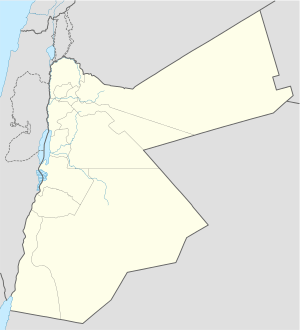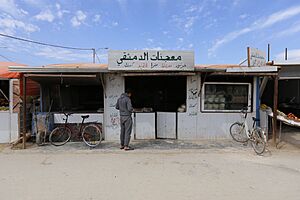Zaatari refugee camp facts for kids
Quick facts for kids
Zaatari
مخيم الزعتري
|
|
|---|---|
|
Refugee camp
|
|
 |
|
| Country | |
| Governorate | Mafraq Governorate |
| Settled | July 2012 |
| Area | |
| • Total | 2.0 sq mi (5.2 km2) |
| Population
(2022)
|
|
| • Total | 82,000+- |
| • Density | 62,710/sq mi (24,212/km2) |
| figures from 2 January 2018 (UNHCR) | |
| Time zone | UTC+2 (UTC+3) |
| • Summer (DST) | UTC+3 (UTC+3) |
| Area code(s) | +(962) |
| Website | www.unhcr.org |
The Zaatari refugee camp (Arabic: مخيم الزعتري) is a large refugee camp in Jordan. It is located about 10 kilometers (6 miles) east of Mafraq city. This camp has grown over time into a more permanent community. It is the world's largest camp for people who have fled the conflict in Syria.
Zaatari camp first opened on July 28, 2012. It was created to help Syrians escaping the violence from the Syrian War, which started in March 2011. The camp is connected to the main road network by a short road that leads to Highway 10.
In the early days, there were challenges with getting enough food and proper homes for everyone. People in the camp sometimes held peaceful demonstrations. These were to share their feelings about the conflict and express their views on the situation in Syria. In March 2013, the camp reached its maximum capacity of 60,000 refugees. Because of this, a second camp was built. This new camp was located 20 kilometers (12 miles) east of Zarqa.
In 2015, two filmmakers, Zach Ingrasci and Chris Temple, lived in Zaatari for a month. They made a documentary called Salam Neighbor about their experiences.
Camp Population and Growth
It became difficult to count the exact number of refugees in the camp after March 2013. This was because so many people arrived very quickly. The numbers changed daily as some people left the camp to return to Syria. Also, early counts sometimes had small errors. People living in the camp have some limits on leaving. They need special permits to go outside the camp for a short time.
How the Population Grew
Since it opened in July 2012, Zaatari camp's population grew very fast. In just a few months, it became the largest community in Mafraq Governorate.
- On August 27, 2012, the camp had 15,000 refugees. This was about 10% of all Syrian refugees in Jordan at that time.
- By September 6, 2012, 30,000 Syrian refugees lived in the camp. This made up about 30% of all Syrian refugees in Jordan.
- On November 29, 2012, the number of refugees reached 45,000. At this time, about 230,000 Syrian refugees were in Jordan overall.
- By January 10, 2013, the camp's population was 65,000. This was 22% of all Syrian refugees in Jordan.
- On February 5, 2013, the camp had 76,000 refugees. More than 345,000 Syrian refugees were in Jordan in total.
- In March 2013, many more refugees crossed into Jordan from southern Syria. By March 11, over 156,000 refugees were in the camp. This made Zaatari possibly the fourth largest city in Jordan at that time.
- On April 30, 2014, another refugee camp opened in Azraq. New refugees now go to Azraq. The number of refugees in Zaatari slowly went down. By September 2014, Zaatari had about 79,000 refugees, according to the UNHCR.
- On March 26, 2015, the camp population was around 83,000 refugees. In August 2015, it was estimated to be about 79,900.
- On October 31, 2018, the camp housed about 78,357 refugees. Nearly 20% of them were under five years old. Also, 20% of the families were led by women.
Power and Energy
The largest solar power plant ever built in a refugee camp started working on November 13, 2016. This plant helps reduce carbon dioxide emissions from the camp by 13,000 metric tonnes each year. This is like saving 30,000 barrels of oil. It also saves about US$5.5 million every year.
The solar plant cost 15 million euros (about US$17.5 million). It was paid for by the German government through the KfW Development Bank. This 12.9 megawatt peak solar photovoltaic plant gives families electricity for 12 to 14 hours each day. This is much longer than they had before.
Support and Services
Jordan, as the host country, spends a lot of money helping Syrian refugees. It is estimated to spend $870 million each year. The Zaatari camp is managed together by the Syrian Refugee Affairs Directorate and UNHCR. In March 2013, Kilian Kleinschmidt became the Senior Field Coordinator for the camp. Later, in late 2014, Hovig Etyemezian took over as the camp manager. Many other groups also help out in the camp.
Community Help
- Intersos gives out items like stoves, blankets, and winter clothes. This is part of a program to help people during the colder months.
- International Relief and Development Inc. (IRD) also helps with community support.
Medical Care
Many organizations provide medical help in the camp:
- Arabian Medical Relief
- Médecins Sans Frontières (Doctors Without Borders)
- International Medical Corps
- French military field hospital (specializes in war injuries)
- Moroccan military field hospital
- Syrian American Medical Society (SAMS)
- Italian Field Hospital
- United Arab Emirates Red Crescent
- Jordan Hashemite Charity Organization (JHCO)
- Jordan Health Aid Society International (JHASi), a partner with UNHCR
- Jordanian Red Crescent
- Handicap International
- IOM / International Organization for Migration (helps with health checks and connecting people to Jordanian hospitals)
- IFH Noor Al-Hussein Foundation, a partner with UNHCR and UNFPA
- Two clinics run by UNFPA for basic health care and reproductive health care.
Water, Sanitation, and Hygiene (WASH)
- UNICEF helps coordinate and is responsible for water, sanitation, and hygiene.
- Federal Agency for Technical Relief THW built 160 kitchen units and 380 toilets.
- MSB (Swedish Civil Contingencies Agency)
- MercyCorps
- Oxfam
Food and Supplies
- World Food Programme (WFP) provides food for the refugees.
Hygiene Promotion
- ACTED works on water treatment, water testing, and managing waste (liquid and solid).
- JEN (formerly Japan Emergency NGOs)
- Oxfam
Education for Children and Youth
- UNICEF
- SCJ/Save the Children - Jordan helps Syrian refugee children in Zaatari camp go to school. This is part of their educational outreach program.
- Mercy Corps offers informal education and emotional support for children aged 5–17. They focus on programs for children and youth with disabilities.
- UNESCO supports educational activities for young people, job training, and higher education.
- International Rescue Committee (IRM) looks into gender-based violence issues.
- International Organization for Migration (IOM)
- UNFPA (United Nations Population Fund)
- Norwegian Refugee Council provides informal education services.
- Lutheran World Relief (LWR) offers peace-building, music, and arts workshops. They also provide job training and emotional support for youth aged 14–30 at the "Peace Oasis."
Protecting Women and Children
- International Rescue Committee(IRC) runs four centers for women. They also work with UNICEF to care for children who are alone or separated from their families.
Other Important Work
- World Vision International works on projects like water drainage and building roads.
- International Committee of the Red Cross helps find families and relatives of refugees.
By 2016, Zaatari camp started to change how it provided services. Instead of organizations doing everything, the camp began to help refugees meet their own needs. The UNHCR encouraged this by giving refugees cash assistance. This helped the camp become more like a self-sufficient town.
Mapping the Camp
As of March 2018, Zaatari's shelters and other buildings had been mapped over 25 times. This was done using satellite images by UNOSAT. Zaatari is one of the first camps to be mapped in detail using OpenStreetMap.
Images for kids
-
USAID personnel visit the camp
-
Iman Mutlaq visits the Zaatari refugee camp for implementing psychosocial support by the IAHV, Jordan; co-funded by the European Union for the Syrian refugees.
See also
 In Spanish: Zaatari para niños
In Spanish: Zaatari para niños







